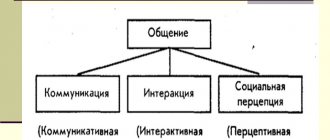Essential characteristics of communication
Definition 1
Communication is a means of communication between people, during which psychological contact occurs, manifested in mutual influence, exchange of information, mutual understanding and mutual experience.
Within the framework of the psychological approach, communication is considered as a specific form of activity and an independent process of interaction necessary for the successful implementation of other types of human activity. In psychological research, communication is presented as one of the needs of the individual and as a factor in its self-formation.
The content of communication is very diverse:
- Information exchange.
- Perception of each other.
- Carrying out mutual assessment.
- Exerting mutual influence.
- Interaction.
- Management of various activities.
Are you an expert in this subject area? We invite you to become the author of the Directory Working Conditions
Communication functions are distinguished in accordance with the content of communication:
- The communicative function is aimed at establishing relationships between people at the social, individual and group levels.
- Information function – carries out the exchange of information between people.
- Cognitive function – aimed at verbal expression and comprehension of one’s thoughts, ideas, fantasies, etc.
- The emotive function is the implementation of the emotional relationship between a person and the surrounding reality.
- Conative function – aimed at managing and correcting mutual positions.
- The creative function is aimed at the comprehensive development of people, the formation of various relationships between them.
Additional communication features include:
- Expressive function – aimed at achieving mutual understanding between people, sharing their experiences and emotional states.
- The function of social control involves regulating the activities and behavior of people.
- The socialization function is aimed at developing the skills necessary for successful interaction with the surrounding society and people, in accordance with generally accepted norms and rules.
Finished works on a similar topic
Course work The essence of communication and its main types 480 ₽ Essay The essence of communication and its main types 250 ₽ Examination The essence of communication and its main types 190 ₽
Receive completed work or specialist advice on your educational project Find out the cost
If at least one of the functions is impaired or lack of communication suffers.
The essence of communication: its functions, sides, types, forms, barriers
There are two main types of social contacts: activity, which has already been discussed in a separate lecture in the second section, and communication, which will be discussed in detail in the proposed lecture.
There are differences between communication and activity, as types of human activity. The result of an activity is usually the creation of some material or ideal object or product (for example, the formulation of a thought, idea, statement). The result of communication is the mutual influence of people on each other. Both activity and communication should be considered as interconnected aspects of social activity developing a person.
In real human life, communication and activity as specific forms of social activity appear in unity, but in a certain situation they can be realized independently of each other. The content of the category of communication is diverse: it is not only a type of human activity, but also a condition and the result of this same activity; exchange of information, social experience, feelings, moods.
Communication is characteristic of all higher living beings, but at the human level it takes on the most perfect forms, becoming conscious and mediated by speech. There is not even the shortest period in a person’s life when he is out of communication, out of interaction with other subjects. In communication, the following are distinguished: content, purpose, means, functions, forms, sides, types, barriers.
Content is information that is transmitted from one living being to another in inter-individual contacts. The content of communication can be information about the internal motivational or emotional state of a living being.
The content of communication can be information about the state of the external environment, for example, signals of danger or the presence of positive, biologically significant factors, such as food, somewhere nearby.
In humans, the content of communication is much broader than in animals. People exchange information with each other that represents knowledge about the world: rich, lifetime experience, knowledge, abilities, skills and abilities. Human communication is multi-subject, it is the most diverse in its internal content. In terms of content, communication can be presented as:
Material is the exchange of products and objects of activity, which in turn serve as a means of satisfying the actual needs of subjects.
Cognitive – knowledge sharing.
Active – exchange of actions, operations, skills. An illustration of cognitive and active communication can be communication associated with various types of cognitive or educational activities. Here, information is transmitted from subject to subject that expands horizons, improves and develops abilities.
Conditional – exchange of mental or physiological states. In conditional communication, people exert influence on each other, designed to bring each other into a certain physical or mental state, for example, to lift the mood or spoil it; excite or calm each other, and ultimately have a certain effect on each other’s well-being.
Motivational – exchange of motivations, goals, interests, motives, needs. Motivational communication has as its content the transfer to each other of certain motivations, attitudes or readiness to act in a certain direction.
For example, one person wants to ensure that another has a certain desire to arise or disappear, so that a certain attitude towards action develops, a certain need is actualized, etc.
The purpose of communication is what a person does for this type of activity. In animals, the purpose of communication may be to encourage another living being to take certain actions, or to warn that it is necessary to refrain from any action. A person's number of goals increases.
If in animals the goals of communication usually do not go beyond satisfying their biological needs, then in humans they are a means of satisfying many different needs: social, cultural, cognitive, creative, aesthetic, the needs of intellectual growth, moral development and a number of others.
According to goals, communication is divided into biological and social.
Biological is communication necessary for the maintenance, preservation and development of the organism. It is associated with the satisfaction of basic organic needs.
Social communication pursues the goals of expanding and strengthening interpersonal contacts, establishing and developing interpersonal relationships, and personal growth of the individual. There are as many private types of communication as there are subtypes of biological and social needs. Let's name the main ones.
Business communication is usually included as a private moment in any joint productive activity of people and serves as a means of improving the quality of this activity. Its content is what people are doing, and not the problems that affect their inner world,
Personal communication, on the contrary, is focused mainly around psychological problems of an internal nature, those interests and needs that deeply and intimately affect a person’s personality; searching for the meaning of life, determining one’s attitude towards a significant person, towards what is happening around, resolving any internal conflict.
Instrumental - communication that is not an end in itself, is not stimulated by an independent need, but pursues some other goal other than obtaining satisfaction from the act of communication itself.
Target communication is communication, which in itself serves as a means of satisfying a specific need, in this case, the need for communication.
In human life, communication does not exist as a separate process or an independent form of activity. It is included in individual or group practical activity, which can neither arise nor be realized without intensive and versatile communication.
Means of communication can be defined as methods of encoding, transmitting, processing and decoding information transmitted in the process of communication from one living being to another. Encoding information is a way of transmitting it from one to another. Information can be transmitted through direct bodily contact: touching the body, hands, etc.
Information can be transmitted and perceived by people at a distance, through the senses (observation by one person of the movement of another or the perception of sound signals produced by him). Man, in addition to all these natural methods of transmitting information, has many that are invented and improved by him.
This is language and other sign systems, writing in its various types and forms (texts, diagrams, drawings, drawings), technical means of recording, transmitting and storing information (radio and video technology; mechanical, magnetic, laser and other forms of recording). In terms of his ingenuity in choosing means and methods of communication, man is far ahead of all living creatures known to us that live on planet Earth.
The functions of communication are distinguished in accordance with the content of communication. There are four main functions of communication. When combined, they give specificity to communication processes in specific forms.
The instrumental function characterizes communication as a social mechanism for managing and transmitting information necessary to perform an action.
The integrative function reveals communication as a means of uniting people.
The function of self-expression defines communication as a form of mutual understanding of the psychological context.
The translation function acts as a function of transferring specific methods of activity, assessments, etc.
Of course, these four functions do not exhaust the meaning and characteristics of communication.
Other functions of communication include: expressive (the function of mutual understanding of experiences and emotional states), social control (regulation of behavior and activities), socialization (formation of interaction skills in society in accordance with accepted norms and rules), etc.
Communication is extremely diverse in its forms. We can talk about direct and indirect communication, direct and indirect, mass and interpersonal.
In this case, direct communication is understood as natural contact “face to face” using verbal (speech) and non-verbal means (gestures, facial expressions, pantomime), when information is personally transmitted by one of its participants to another.
Indirect communication is characterized by the inclusion of an “additional” participant in the communication process as an intermediary through whom information is transmitted.
Direct communication is carried out with the help of natural organs given to a living being by nature: hands, head, torso, vocal cords, etc. Direct communication is historically the first form of communication between people with each other; on its basis, in the later stages of the development of civilization, various types arise mediated communication.
Indirect (that is, through something) communication can be considered as incomplete psychological contact with the help of written or technical devices that make it difficult or delay in time the receipt of feedback between the participants in communication.
Indirect communication is associated with the use of special means and tools for organizing communication and exchanging information. These are either natural objects (a stick, a thrown stone, a footprint on the ground, etc.) or cultural ones (sign systems, recordings of symbols on various media, print, radio, television, etc.).
Further, a distinction is made between interpersonal and mass communication.
Mass communication is multiple, direct contacts of strangers, as well as communication mediated by various types of media.
Interpersonal is associated with direct contacts of people in groups or pairs with a constant composition of participants. It implies a certain psychological closeness of partners: knowledge of each other’s individual characteristics, the presence of empathy, understanding, and joint experience in activities.
A modern specialist in the field of trade and services has to pay the greatest attention to interpersonal communication in his daily activities, and therefore face certain problems of both a verbal and non-verbal nature. Let's give these problems the attention they deserve.
In accordance with the established tradition, in domestic social psychology there are three different types of interpersonal communication in their orientation: imperative, manipulation and dialogue.
Imperative communication is an authoritarian, directive form of influencing a communication partner in order to achieve control over his behavior and internal attitudes, forcing him to take certain actions or decisions.
In this case, the communication partner is considered as an object of influence and acts as a passive, “suffering” party. The peculiarity of the imperative is that the ultimate goal of communication - coercion of a partner - is not veiled. Orders, instructions, instructions and requirements are used as means of describing influence.
Manipulation is a common form of interpersonal communication that involves influencing a communication partner in order to achieve one’s hidden intentions. Like the imperative, manipulative communication presupposes an objective perception of the communication partner, who is used by the manipulator to achieve his goals.
They are also related by the fact that during manipulative communication the goal is also to achieve control over the behavior and thoughts of another person. The fundamental difference is that the partner is not informed about the true goals of communication; they either simply hide from him or are replaced by others.
In the manipulative process, the communication partner is perceived not as an integral unique personality, but as a bearer of certain properties and qualities “needed” by the manipulator. So, it doesn't matter how kind this person is, what matters is that his kindness can be used, and so on. However, a person who chooses this type of relationship with others as his main one often ends up becoming a victim of his own manipulation.
He also begins to perceive himself fragmentarily, switches to stereotypical forms of behavior, is guided by false motives and goals, losing the thread of his own life. A manipulative attitude towards another leads to the destruction of close, trusting ties between people.
A comparison of imperative and manipulative forms of communication reveals their deep internal similarities. Putting them together, we can characterize them as different types of monologue communication. A person, considering another as an object of his influence, essentially communicates with himself, with his goals and objectives, without seeing the true interlocutor, ignoring him. As A. A. Ukhtomsky said about this, a person sees around him not people, but his “doubles”.
- Concept and specificity of communication.
- Communication functions.
- The essence of the communication process.
- Forms of communication and their culture.
- Classification of communicative acts.
- Installation concept.
- Language as a type of communication.
- The relationship between communication and etiquette.
- Bibliography:
Can you communicate? I'm sure everyone will say: “Yes, of course.” But in what form does this communication take place? Most often it is just a conversation, an exchange of information. At the same time, everyone knows that the concept of “communication” is much broader than our usual: “Hello!” - "Bye".
If you look into the past, then we, who consider ourselves modern people, will simply feel ashamed. After all, people, already from the 16th-17th centuries, communicated at such a high level that we never dreamed of. Now we are making excuses to ourselves, saying, “This is a crazy time, we don’t even have time to sit down, let alone talk.” And, comforting ourselves with this thought, we continue to communicate at the same low level.
Assuming that “I know how to communicate” means: “I know how to communicate correctly,” and this is the only way to understand the question posed, then the answer to it can be considered insufficiently modest. Although speech plays a huge role in people’s communication, everyone knows perfectly well that people, for example, those who love, do not need words to express their feelings and thoughts. It is enough for them to see each other. This fact is confirmed in the novel by L.N. Tolstoy's "Anna Karenina", in the scene of Kitty and Levin's explanation, when they, without uttering a word, write in chalk on the green cloth of the table for card games only the initial letters of words that make up sentences that are very complex in syntax and content.
Communication between people is the most important feature of human existence. Without it, activity, formation and assimilation of spiritual values, formation and development of personality are impossible. Communication accompanies all these processes and contributes to their implementation. Communication is multifaceted, primarily because it is implemented at different levels: countries and peoples, parties, collectives and individuals can communicate, accordingly, the interaction between the parties in this process will differ in its social significance. In addition, communication can manifest itself in different ways: be direct or indirect, vary in type and, finally, in the process, people can exchange thoughts, feelings, experiences, work skills, etc.
The enormous importance of interpersonal communication is explained by the most important functions it performs. Firstly, communication involves the exchange of information between people. The information and communication function in one form or another is associated with all forms of human activity. Even thought processes, according to some scientists, proceed more effectively under the condition of continuous information communication.
Communication performs the so-called regulatory-communicative function. In communication, rules of behavior, goals, means, and motives for behavior are developed, its norms are learned, actions are evaluated, and a unique hierarchy of values is formed. It is not surprising that it is in communication that a person learns and experiences his significance.
Communication regulates the level of emotional tension, creates psychological release and ultimately forms the emotional background against which our activities are carried out and which to a large extent determines the very perception of the world. This function of communication in social psychology is called affective-communicative. In real communication, all its functions organically merge, regardless of its form.
So, the process of communication, communication. Firstly, it consists directly of the very act of communication, communication, in which the communicants themselves participate, i.e. communicating. Moreover, in the normal case there should be at least two. Secondly, communicants must perform the action itself, which we call communication, i.e. do something (speak, gesture, allow a certain expression to be “read” from their faces, indicating, for example, the emotions experienced in connection with what is being communicated). Thirdly, the message is characterized by some content, some form and some meaning. It's not the same thing. Let's say that someone (say, a young man) presents someone (say, a girl he knows) with a bouquet of yellow tulips. And he does it in an unusual way: without a smile, with an aloof expression on his face. In terms of form (let’s say it’s pronounced: “Please take the flowers from me”), everything here is stylistically, grammatically and etiquette-correct. The content - “transfer or offering of flowers” - is clear and may well be generally assessed positively. But the meaning is special: “a young man breaks up with a girl.” Remember that his face was serious, and the tulips were yellow (yellow has long been a symbol of parting, separation). Of course, the true meaning of a real communicative act of this kind may be different if the young man could only get yellow tulips or did not even know that the color yellow is a symbol. An unfriendly facial expression can be determined by circumstances that have nothing to do with the date. It was only important to give an example of the meaning that is generally possible in this situation, to show how meaning can differ from both the content and the form of a specific communicative act. It is further necessary to determine the communication channel in each specific communicative act. When talking on the phone, such a channel is the organs of speech and hearing; in this case, they talk about the audio-verbal (auditory-verbal) channel, or more simply, the auditory channel. The form and content of the letter are perceived through the visual (visual-verbal) channel. A handshake is a way of conveying a friendly greeting through the kinesico-tactile (motor-tactile) channel. If we learn from the suit that our interlocutor, say, is Uzbek, then the message about his nationality came to us through the visual channel (visual), but not through the visual-verbal channel, since no one told us anything verbally (verbally).
An important component of the communicative act are the motives of the participants in communication, i.e. their goals and intentions. A teacher, for example, wants to communicate something to students in a lecture so that they learn it. It happens that some students do not want to learn this something at the same time. Then they talk about “scissors in intentions” (intentions). Communication in such cases either becomes difficult or comes to a null result.
Finally, everyone is well aware that during an act of communication a person can say one thing and think another, i.e. lies or simply keeps silent about something for some (not necessarily bad) reasons. In a number of cases (and with the help of scientific methods - always) it is possible to detect dissociation (i.e. mismatch) between the form and content of the message. Forensic scientists, for example, know well how important it is to observe the facial expression and appearance of the person being interrogated during testimony. Yes, and you and I, not being specialists, often say something like: “I can see in my eyes that it’s not true,” “he’s talking about fun things, but he’s still walking around, not finding a place for himself—something is bothering him. You ask, “everything’s okay,” but in reality...”
Consequently, if we want to be understood correctly, it is necessary that both form and content harmoniously merge with each other, without introducing elements of dissociation. And communication channels must be free from “noise” (as experts call any, not just audio, interference). While talking, it is not good to turn away, do other things (for example, leaf through a book), you cannot, in a word, “make noise” of the communication channel. Naturally, you need to choose the optimal voice volume - speak loudly enough, but not deafen, keep the optimal communication distance (there are even special interesting studies about this). Poor handwriting is not such a harmless flaw when you think that it can prevent the recipient from easily and correctly understanding the written letter. Haven’t you yourself experienced irritation while struggling to decipher someone’s scribbles?
Communication between people occurs in various forms, which depend on the level of communication, its nature, and purpose. The most typical forms of interpersonal communication are anonymous, functional-role communication, in which work relationships, informal and intimate family communication occupy a special place. The above classification is, of course, conditional. It does not exhaust all possible forms of communication in which a person can participate.
Let's look at the basic forms in more detail.
Anonymous communication is interaction between strangers or people with no personal relationship. It is understood as any temporary connections between people in which they act as citizens, residents of a city or town, passengers of a train, plane or public transport, spectators of a cinema or sports match, visitors to a museum or exhibition, etc. This refers to their prior and, as a rule, subsequent unfamiliarity. They meet, enter into relationships with each other and go their separate ways. They are anonymous, nameless in relation to each other.
Formal-role communication involves varying durations of communication between people who have certain roles. Participants in such communication perform certain functions in relation to each other: buyer - seller, passenger - conductor, waiter - client, doctor - patient, etc. Service relationships are also of a functional-role nature, but they are characterized by a significant duration; they, as a rule, are of great importance in people’s lives. Their participants know each other to a greater or lesser extent, at least as workers, members of the same team.
Informal communication represents all kinds of personal contacts outside the formal relations of colleagues and members of any organizations. Of course, informal communication is also possible with workmates, but only if it goes beyond the scope of work relationships. Examples could be non-official contacts with workmates, acquaintances, meetings with friends, comrades in sports and other hobbies, etc. A special area of informal communication is communication between close people or family members.
If we consider the communicative acts themselves according to their types and types, then, depending on different classification criteria, we would get different varieties: in content: production, practical-everyday, interpersonal-family, scientific-theoretical; by form of contact: direct, indirect. For example, correspondence is an indirect form of contact between communicants, and personal conversation is a direct form of contact; by type of communication: bidirectional and unidirectional. For example, reading a book, or watching a movie, or playing the role of a spectator at a play is a unidirectional communicative act. But if you applaud actors, or write a letter to the author of a play, book or film director, or reward singers with applause, the connections become bidirectional, mutual; according to the degree of mutual correspondence between communicants: high, satisfactory, insignificant, unsatisfactory, negative. If the degree of mutual correspondence is unsatisfactory (in such cases, it is about communicative incompatibility and even about complete psychological incompatibility), it is appropriate to state: “they speak different languages.” Although they do not mean different national languages at all, but, for example, completely incompatible passions, interests, manners of speaking and communicating in general; according to the results: from negative (“he completely misunderstood me, distorted my thought”) through zero (“we just can’t understand each other”) to positive (“he understands me, and I understand him”). The scale of negative and positive results is quite stretched: we can understand someone in such a way that he will be delighted, or we can simply cause a nod of approval. Misunderstanding can border on a distortion of understanding. This is why it is necessary to strive for maximum success in communication.
There are people who are not very talkative. They may listen to you with attention, but at the same time you will not see it. It seems to you that they simply don’t want to listen to you, but in fact, your interlocutor has such a habit and for him this is the norm of communication. People who either have a respected position in society or are tall and large in size often behave this way. Often, when talking with such people, we feel uncomfortable, embarrassed, and sometimes we stop, because... it seems to us that we are not being listened to very carefully or are simply being ignored. This is often facilitated by our own attitude before the conversation. If someone told us something that does not honor the interlocutor before the conversation, then we develop alienation, and not always legitimately so.
Installation is a very unpleasant thing. It can interfere with the start of a conversation or lead to conflict in the communication process. There is confirmation of this in Gogol’s “The Inspector General”:
“Governor... Let me invite you to move with me to another apartment.
“Khlestakov. No I do not want to! I know what it means to go to another apartment: that is, to prison! What right do you have? How dare you?.. Yes, here I am... I serve in St. Petersburg. (Being cheerful.) I, I, I...
Mayor (to the side). Oh, my God, so angry! I found out everything, they told me everything, damned fools!
Mayor (stretched out and trembling with his whole body). Have mercy, don't destroy! Wife, small children... don’t make a person unhappy.
Khlestakov. No I do not want! Here's another! What do I care? Because you have a family and children, I have to go to prison, that’s great!.. No, thank you humbly, I don’t want to.”
Despite the fictionality and conventionality of the comedic situation, it is distinguished by a deep understanding of a very important psychological phenomenon, which experts call “attitude.” In this case, the mayor and Khlestakov reveal their own attitudes when they meet, i.e. their own meaningful ideas about what could happen, what the characters think should happen. After all, the mayor was waiting for the arrival of the auditor, he believed Bobchinsky and Dobchinsky that the auditor was already here, that he, the mayor, was talking to the auditor, who needed to be softened, brought to his side, “greased” and thereby avoid the collapse of his career. And Khlestakov knew that he owed money at the hotel, and therefore, trouble awaited him, and arrest was not ruled out, since he would not be able to pay off his debts. That is why the mayor does not doubt the strength of Khlestakov, the auditor, and Khlestakov does not doubt the mayor’s intentions to arrest him. At the same time, they both do not notice signs of another reality, interpret each other’s remarks solely against the background of their own attitudes.
Attitudes of all kinds play an extremely important role in the theoretical and practical activities of a person and clearly appear in communication processes. In order not to get into trouble yourself and not to embarrass your interlocutor, you need to know what an attitude is, how it develops in the conditions of communication, how it can be changed and how it should be managed. Do this experiment in your mind (or in practice!). You and your friend are in the cinema. The lights went out and the film began showing. Everyone (including you and your friend) is closely watching what is happening on the screen. Suddenly you ask your friend (in a whisper, of course, but so that you can be heard): “Please remember the name of an egg-laying mammal. Platypus, or what? If the film is not thematically connected at the moment with your platypus and zoology in general, you can rest assured that your question will not even be heard. They will definitely ask you again. But if you ask something relevant regarding the plot of the film, the characteristics of the actor, etc., they will answer you. Even if you ask your question more quietly than the first. Why? Yes, because it is “appropriate”, “clear” what refers to the most probable in a given situation, what is customary to talk about in a given situation, what is included in the “setting for the perception of a given film”. Everything else turns out to be outside the field of attention, and therefore is not recognized or understood.
In everyday communication, often someone suddenly (precisely “suddenly,” that is, unexpectedly) begins to tell an incident from his life or, say, an anecdote, while neither one nor the other is expected from him. Some people begin a conversation as if continuing to develop their own thoughts, which they themselves were absorbed in, and no one present had any idea about them. For example: “Do you think this is correct?!” — an elderly man once asked irritably the woman standing next to him on the bus. She was confused: “Sorry, but I don’t understand you... We don’t seem to know you…”. It turned out that the elderly angry man wanted to do the confused woman a favor: the compassionate mother standing next to her seated her healthy and cheerful daughter, about eight or nine years old, in the vacant seat. Instead of this girl, what the angry man believed should have sat down was a woman who had not paid any attention to what had happened. With his exclamation, which continued the train of his thoughts, the man seemed to invite him to condemn the wrong act of the girl’s mother. But is it possible to understand his intentions by his exclamation? I had to explain, waste nervous effort, waste time...
It happens that a person is having fun, he is in a good mood, and he wants to share it with others. Is it bad? And a funny joke is already told or the reason for the joyful state is explained. But at the same time, a person may not notice that others are tuned in “to a different wavelength.” Something might upset them. They may be grieving the loss of a friend or loved one. How can a joke sound against the backdrop of such an attitude? What does a wide smile look like under these conditions? We will rightly call them manifestations of tactlessness. This means that when starting a conversation, check whether it is appropriate to start talking at all, whether you need to say what you want. In a word, when entering into communication, start with “orientation” in the communication situation: always answer your own mental questions about who is in front of you, what and how you can (and whether it is necessary at all) to talk about.
Very often we have to face a situation where our own joke does not cause the expected reaction, be it laughter or at least a smile. What if we ourselves don’t find anything funny in a friend’s joke? What to do then? Moreover, if someone made fun of someone else, and this second one was offended. Usually those people who have a great sense of humor start communication well, but those who lack this important feeling find it difficult to start a conversation or get to know each other. “If a person doesn’t understand a joke, he’s lost!” And you know: this is no longer a real mind, even if a person is even seven spans in the forehead!” - these are the words of Anton Pavlovich Chekhov. You can agree with this, you can disagree, but the fact remains that not every one of us has a sense of humor. The difficulty of discovering that you have an underdeveloped sense of humor lies in the fact that there are no people who do not laugh, who do not find it funny. But laughter can be caused by different reasons. If these reasons are insignificant or cannot at all be, strictly speaking, reasons for fun, then the saying is appropriate here: “Laughter without a reason is a sign of a fool.” For example, it is not appropriate to laugh at the sight of a fallen plump woman walking down the street carrying a heavy bag of groceries. But there are people for whom this is funny, and the funnier the more different things roll out of the fallen bag, the more noise there is. A person who can laugh at this probably cannot think of anything funnier than removing a chair from under a person sitting on it. We can almost say with complete certainty that such a “joker” has not yet matured to understand what is truly funny and has little or no knowledge of the best examples of humor. But this does not mean that a sense of humor cannot be developed. After all, it is possible (and this has been experimentally proven) to develop an ear for music. How to do it? To do this, you will have to work a little, although the work will subsequently be rewarded beyond measure with good laughter. It will probably be necessary to read humorous essays and novels, for example, not forgetting about “The Adventures of the Good Soldier Schweik.”
The most common type of communication is conversation. During a conversation, we use a language, whether it is our native or a foreign one, in any case it is necessary.
Language is a priceless gift that a person is endowed with. “You can’t tell it with your tongue, you can’t spread it with your fingers,” people say. With the help of words you can tell about everything. “The main character of our language is the extreme ease with which everything is expressed in it: abstract thoughts, internal lyrical feelings, a cry of indignation, sparkling prank and amazing passion,” wrote A.P. Herzen. Language is a human tool. It is necessary so that people can fully communicate. It is true, of course, what is sung in the old song, “after all, sometimes silence is clearer to us than many words.” But this happens sometimes. And in everyday communication, we most often lack precisely the word, and we “writhe, tongueless,” trying to find it, this is the only necessary, correct, accurate one. “You waste, for the sake of a single word, hundreds of tons of verbal ore...” This is not only about poets and poetry. This is also true in everyone who values what is expressed and strives to weigh his word, understanding that it is a powerful irritant and can have a huge impact on a person: a word can kill, a word can save.”
Communication through speech ensures the success of joint activities. When we want to express our attitude towards the confusion reigning around us, we say: “Babylonian pandemonium!” The origins of these winged words are in the biblical legend about the construction in ancient Babylon of a tower to the sky (“pillar of creation”), which ended in failure, since God became angry, confused the languages of people, and they ceased to understand each other. “We speak different languages with you, we cannot find anything in common,” we conclude bitterly when there is no mutual understanding and the relationship does not work out. Communication through words (speech communication) consolidates and preserves the experience of humanity, passing it on from generation to generation, because language is a tool of culture.
More than 3.5 thousand languages of the world reflect in many ways all the achievements of science, technology, and art. Interest in the native language, the desire for perfect mastery of its written and oral forms always characterize a cultured person. There is no sphere of communication where good command of the language and the ability to use this invaluable gift bequeathed to us by our ancestors are required.
Do we know our native language? “Of course,” many will answer. After all, we have been using it since childhood. And at school they studied all sorts of declensions and conjugations. A foreign, unfamiliar language is another matter. “But it turns out that “declension-conjugation”, and indeed all grammar, is only an integral part of the language. And that’s not the only point. The main thing is that language is the most important means of communication.
The word “etiquette” is of French origin and means “tag”, “label”. In European languages, incl. and in Russian, it has become generally accepted and is used to denote external forms of cultural behavior.
Etiquette is “an established order of behavior, forms of behavior in any communication.” Initially, etiquette denoted the rule of palace ceremonial at the French royal court, then it spread in aristocratic circles.
Etiquette in modern society has a number of varieties: diplomatic, military, business, everyday informal communication. Etiquette is formalized, agreed upon rules of conduct accepted in a given society or social group, through which respect for the individual and his dignity is expressed, ease of communication is created, and compliance with aesthetic tastes is ensured.
The content of etiquette covers the rules of behavior in mass, repeated situations: greetings at meetings and farewells, behavior at the table, in public places, etc.
Etiquette allows us not only to do the right thing in mass, repeated situations, but also prescribes certain norms of verbal communication.
Etiquette also determines the rules of behavior in special circumstances of life. So, fun is unacceptable at a funeral, but it is necessary to express sympathy and condolences to family and friends. At a wedding or party, it is customary to be cheerful, friendly, sociable and not spoil the mood of others with a mournful appearance.
At all times and in all established societies, people's behavior is regulated by rules that correspond to a specific communication situation. When the word “etiquette” is uttered, one would like to add: “court,” so the phrase “court etiquette” is often found. And immediately magnificent pictures of ceremonies, brilliant outfits of court ladies with fans and nobles with swords and feathers on their hats come to mind. The gentlemen bow low in intricate bows and make complex and deft movements with their hats, sweeping the sparkling floor with feathers; ladies curtsy, bowing their wigged heads. You can hear the music of leisurely minuets and appeals: “Oh, madam, if only I were allowed to express my admiration!...” It is clear that the challenge to a duel should have been staged by spectacularly throwing the glove at the feet of the offender with words like: “I have the honor to offer you, sir, cross your sword with mine, tomorrow at dawn at the left wall of the monastery of Saint-Germain! And the challenger had to pick up the thrown glove, which would mean: “the challenge to a duel is accepted,” and answer like this, for example: “I have always dreamed of an opportunity, sir, to give you a fencing lesson in exactly the place and time that you yourself deigned to appoint.”
But now we will not talk about the etiquettes of bygone days, familiar from the novels of Dumas or Walter Scott, nor will we dwell on the ceremony of lighting the peace pipe in the North American Indian tribes. There are many books that tell us about the rules of good manners, about behavior in public places, about how to properly set a table, handle a fork and knife, etc., how to invite a person to dance, and give up your seat on a tram. The totality of all the rules of behavior and verbal address constitutes what is called etiquette. Each action, each appeal must, as you know, be accompanied by rituals appropriate to the occasion: “magic words”: please, thank you, etc. You can, of course, forget (if it really happens) about this or that verbal formula accompanying the service, finding something else that is no less suitable. It is only important to always remember that the essence and meaning of etiquette are determined by the internal readiness of one person to help another and what is called delicacy and tact. In other words, do not impose your company while remaining polite; the desire not to interfere with others, while remaining free to carry out one's own actions. And this means, in the end, that you cannot make noise and interrupt others in conversation. If you want to express your opinion (including objections, disagreement with the words or actions of others), you must first inquire whether the interlocutor said everything he wanted, whether he is ready to listen to you. Etiquette, as you may have guessed, includes not only verbal forms of expressing politeness and sympathy. Etiquette of words and actions should not conflict with a person’s appearance or clothing. In other words, etiquette is not completely observed if, despite all the correctness and politeness of behavior, young people come to the theater in jeans and colorful T-shirts. It is even worse if someone wearing bright, extravagant clothing joins the funeral procession.
Even when getting dressed (and even earlier, when purchasing clothes), one must keep in mind that clothing, gait, manner of standing, sitting, even laughing, form a kind of sign system; a person dressed in one way or another declares something, communicates something about himself to others. For example, a wedding dress, a festive suit are signs of an upcoming celebration; a tracksuit, a tennis racket in his hands “say” that the person is an athlete; a careless hairstyle and unkempt jeans indicate that a person neglects the aesthetic feelings of others. Dirt under the fingernails and soiled clothes do not at all signal that a person belongs to the working class. These are simply signs of a slob, to whom neither the rules of personal hygiene nor the concept of aesthetic appearance are available. Loud negotiations during a film show, or a hat left on in the room are signs of bad manners and selfishness.
“They meet you by their clothes, they see you off by their mind,” says Russian folk wisdom. In other words, both your appearance and the words you say are important in communication. Etiquette, as we have already said, regulates communication and interaction between people. You need to take etiquette and the ability to communicate seriously and wisely. The rule is quite simple: what may be unpleasant for you is unpleasant for others.
So, what is still needed to communicate correctly? We must, first of all, respect the interlocutor, listen to him with as much attention as possible, without interrupting and allowing him to speak, and not “noise” the communication channels. It is also necessary to look appropriate so that there is no mismatch, try to say only what we think, so as not to introduce dissociation. All these, if not universal ways of communication, then at least they will help you communicate more correctly and find a common language with people.
Disdain for etiquette and reluctance to follow it is an indicator of a person’s insufficient cultural development, which complicates his relationships with other people. Compliance with etiquette rules creates an atmosphere of friendliness, respect, trust, warmth, and a special psychological climate that overcomes people’s alienation.
Similar works
- Psychology of communication: disclosure of the concept, types and functions of communication
- Psychology of communication: perception in the process of communication
- Psychology of communication
- Psychology of communication: the role of perception in the communication process
- Psychology of communication: types, concept of communication
- Psychology of communication: definition, types and functions
- Psychology of communication: concept, types and functions
- Psychology of communication: functions of communication, errors in perception
- Psychology of communication: concept, types, definition
- Psychology of communication: types and functions, error of perception
- Psychology of communication (Option No. 10)
- Psychology of communication: types and functions of communication
- Psychology of communication (communication functions and test)
- Psychology of communication
- Psychology of communication: concept, types and function of communication
- Psychology of communication: concept, errors of perception
Introduction.
In psychology, communication is defined as the process of establishing and developing contacts between people, generated by needs and consisting in the exchange of information between them of a cognitive (cognitive) or emotional-evaluative (affective-evaluative) nature. Communication is the basic form of human existence. The absence or lack of communication can deform the human personality.
Communication is at the core of every human activity and serves the vital purpose of connecting and cooperating among people. The ability to communicate is one of the most important human qualities. We have sympathy for people who are easy to get into contact with and know how to win over. We try either not to communicate with closed people at all, or to enter into limited contacts only in cases of extreme necessity.
The purpose of this work is to study the psychology of communication. Tasks to be solved during its implementation:
- Disclosure of the concept, types and functions of communication.
- Studying the role of perception in the communication process.
- Expanding the concepts of stereotype and prejudice.








